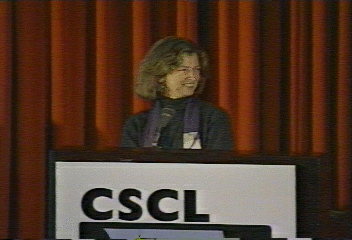
Overview of the Teacher Participation Program
Teacher Participation in CSCL Projects
Panel on Teacher Issues in CSCL
Overview of the Teacher Participation Program (TPP)
Historically, the transfer of instructional technologies from development groups to the classroom has been fraught with difficulties. In many cases, this has been due to a failure to achieve a good match between the needs and requirements of the classroom and the affordances of the introduced technologies. As a result, these technologies are often not compatible with (and, indeed, in some cases represented a challenge to) existing teaching practice. Accordingly, an important goal for the CSCL research community has been to draw classroom practitioners into the activities of the field at relatively early stages of development and enlisting their help in plotting future directions for work. The Teacher Participation Program at CSCL '97 was designed to support this kind of exchange.

Jan Hawkins in her introductory remarks to the Teacher's Panel, December 12, 1997
"Collaboration has many faces and many meanings at this conference, I think. One of the most important for us to deliberate is this one. Most require a new collaboration in an intense way between researcher and practitioner settings. We have seen that it is no longer just a problem of designing it and getting it right and then dropping it in. The kind of work is very reciprocal using things in context and revising them in context from the researcher side. From the practitioner side how does all of this mean something in terms of better situations for kids. How is it that this primary responsibility is addressed in the kinds of work that we do?
The conversation between groups is really critical for the group to deliberate at this point in term. The work is now long term involving multiple perspectives, multiple methods and multiple ways of working together and I don't think we have the kinks all worked out as Carl Bereiter's remarks reminded us in his opening address. I think there are problems of methods to discuss for collaborative research and for curriculum collaborative methods and we don't often talk about the latter."
We also have problems of fusing new kinds of communities. I think its wonderful to have teacher strands at this conversation and we have to figure out how to do it more and better because we're talking about a fused conversation. It is more than a matter of listening to each others' point of view and that has yet to develop among us. So what kinds of moves need to be made and listening to the papers in this conference people are talking about the following kinds of moves to fuse the work. These include evolving roles, developing a new and shared language, an enlarged view of purpose, an awareness of the tensions between the two worlds because we are working to multiple purposes and each has its own tensions: tensions of timescale, the nature of evidence that's useful and how its used, and how its talked about, and the organizations in which we work. All of these need to be brought to the surface."
Teacher Participation in CSCL Projects
One of the problems that arise when people present findings from CSCL projects (or other types of instructional technology projects) at conferences is that it is very difficult for listeners to reconstruct how the introduced instructional technologies are actually used in the classroom. At CSCL '97, conference participants visited two elementary schools, Huron Street Public School and the Institute of Child Study, where students and their teachers use Knowledge Forum (second-generation CSILE) technology extensively in support of collaborative knowledge building.
Knowledge Forum is a problem-centered collaborative knowledge medium that operates over a computer network. In the database, students and their teachers can create text and graphic notes, read and build onto each others' notes, and create views to represent different aspects of their collaborative work. It provides the organization for any number of small groups to carry on discussions and debates among themselves and with each other, for students to join in the discussions of whatever group they are interested in, and to realign themselves with other groups as the need arises, and it allows the teacher as well as other students to monitor and contribute to the developing lines of inquiry of each group. The computer system thus provides the organization and support for the complex array of individual and group discussions and development of ideas that constitutes a working knowledge-building community.
During the classroom visits, elementary students showed conference participants their collaborative projects in Knowledge Forum, demonstrated aspects of the software and talked to visitors about their experiences using the software. In several cases students also made use of the visitors' expertise. As one example, two girls were investigating the nature of democracy in ancient Greece. One of the conference participants from Greece questioned the girls about what they had learned so far and they questioned him to get more information. As they talked one of the students entered the visitor's story about Pericles and the concept of hubris into their class database thus adding to the knowledge of the class. As this example and others that occurred during the classroom visits illustrate, communities diverse in age, knowledge and experience can help each other advance their understanding. Future CSCL meetings might want to expand opportunities for cross sector dialogue.
CSILE classroom shots at Huron St. Public School
(Grade 5/6 Class)
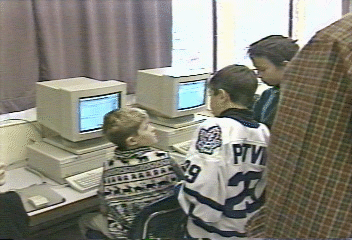
Researcher: "How do you decide who gets to do the research?"
Student: "Each of us enters in our theory and then we all get to do the research."
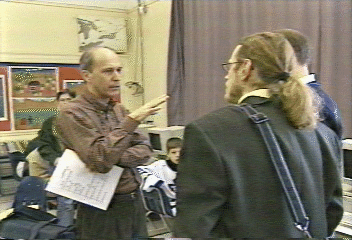
Jim Webb (CSILE teacher): "Each child meets with me at my computer when they're ready to publish their work. We then examine it; I make suggestions; they submit their work to three peer evaluators and finally it gets published. I grade only published CSILE work."
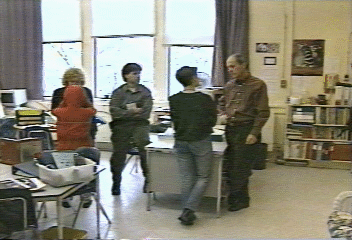
CSCL visitors in Jim Webb's classroom.
CSILE classroom shots at Institute of Child Study Laboratory School
(Grade 5/6 Class)
|
Visit to ICS Lab school |
0.10:35 |
Richard Reeve's in his Institute of Child Study Laboratory School Grade 5/6 classroom introducing CSCL participants to knowledge Forum™ (second generation CSILE) |
|
|
19.53 |
Classroom shot Nathaniel and Howard (students) explaining a current debate in their Knowledge Forum™ database about whether an expressway should be built through Toronto. |
|
|
28.03 |
Sarah (student) and Greek researcher discussing government and politics in ancient Greece. |
|
|
36.54 |
Students explaining how Knowledge Forum works in their classroom. |
Learning through Collaborative Visualization Project (
CoVis)Presenters: John Moore (high school environmental studies teacher, Burlington County Institute of Technology, Medford Campus, New Jersey), Eileen Lento (Project Director of CoVis, Northwestern University)
In their session, Moore and Lento focused on the evolution of the roles of teachers, and researchers in the CoVis project (An overview of the project is presented in Appendix 1). Beginning as a design experiment on the use of software in science education, the project has scaled to become a testbed for problem and project based science learning in K-12 education involving about 100 teachers in 50 sites mainly in the Chicago area. Concomitant with scaling up, changes in professional development activities for teachers, development of curriculum and assessment tools, and construction of an ongoing support system for teachers as they implement CoVis projects in their classrooms have occurred. Lento presented several examples of this evolution, which are shown in the Table below.
|
Problem |
Solution |
|
Initial workshops were researcher driven. Teachers saw the project as primarily about technology and didn't use the software.
|
Current workshops are teacher driven. The project focus is on developing problem- based curriculum supported by technology. |
|
Teachers experienced difficulty using the software in meaningful ways. |
Researchers developed project seeds in the geosciences to help teachers get started. A database of telementors was constructed to bring experts into the classroom electronically. |
|
Teachers experienced difficulty implementing the kinds of pedagogy needed for project-based science learning. |
The project developed interschool activities in order for teachers to support each other. |
|
Administrator support (e.g., installing hardware and providing technical support) was needed to implement the project but administrators didn't understand the project. |
The project created a quarterly newsletter highlighting classroom achievements in project sites. As teachers'work is recognized, administrators and parents became more informed and supportive. |
Thus the project has developed from a researcher-initiated experiment into an iterative design process involving both teachers and researchers. Even so, Lento estimated that only 100 of the approximately 200 teachers who had been trained in CoVis have actually stayed with the project. What are the factors that might impact on whether a teacher adopts this approach?
Moore, as a classroom teacher using the CoVis project as well as other research-based science projects with his high schools students at a technical vocational high school, provided several insights into the factors important for implementing this kind of approach to science learning. Moore's background is in environmental science and his motivation for becoming a teacher was based on his belief that the best way to improve society's treatment of the environment is through education. But education about past scientific discoveries won't do it. He argued that students need to confront real and current environmental issues in much the same way researchers do. Moore selected the CoVis project because it afforded him and his students the opportunity to participate in a scientific community and that process has changed his instructional practices substantially. He commented that he now facilitates students' inquiry and gives much more responsibility to students. Moore concluded !
with recommendations for researchers including the need for researchers to see teachers as intelligent and critical consumers of their research projects; the need for support beyond one shot workshops where teachers get lots of stuff that they don't know how to use once they get back to their classrooms; and the need for researchers to continually improve their products as needs change.
Presentation on Collaborative Visualization Project (CoVis)
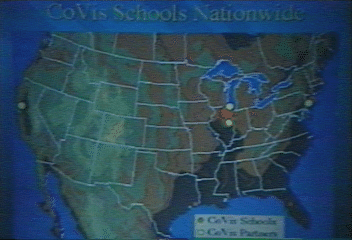
Map of CoVis sites.
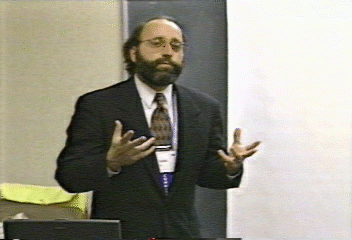
John Moore (Co-Vis teacher): "I am not a technology person. My technology supports are my students and they do the technology supports. This indicates the change in my role as a teacher releasing responsibility to my students."
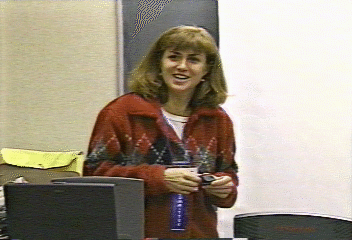
Eileen Lento (CoVis researcher): "We are trying to expand from a project with six sites to a testbed with 50 sites. This has meant that we have turned over much of our professional development work to our teachers."
Presenters: Eileen Bendixsen (Middle School Science Teacher, Hazlet, New Jersey), Bob Spielvogel (Education Development Center, New York)
In this session, Bendixsen and Spielvogel focused on their work aimed at developing new ways to assess student learning in the Passport to Knowledge project (The project is described briefly in Appendix 2). Bendixsen became involved in the project as a way to move from a textbook oriented science curriculum to a laboratory-based course for middle school science. She also facilitates teacher discussions in a network of 4000 teachers who participate with their students in specific projects. Spielvogel directs an NSF funded project designed to assess student learning in the project. In the following Table, teacher and researcher concerns in assessment are highlighted.
|
Research Goal |
Classroom Implication |
|
Assessment through student peer review |
How to teach students the skill of constructive criticism and how to react to criticism |
|
Need for concrete data |
Teachers use impressionistic data to evaluate group learning in projects |
|
Summative assessment at the end of specific projects |
Formative assessment needed as the project develops |
|
Researcher developed assessment forms |
Teachers needed advance knowledge of the assessment forms |
This presentation highlighted the need for collaboration between teachers and researchers in the design of assessment instruments. Through sustained communication Bendixsen and Spielvogel arrived at a new design in which teachers are given opportunities to understand how to implement peer assessment into projects and where the peer assessment are used iteratively to help students improve their projects.
Passport to Knowledge Presentation
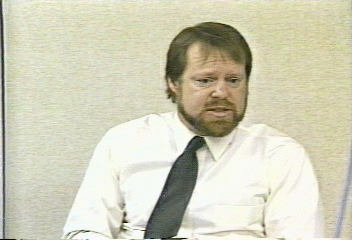
Bob Spielvogel (Passport to Knowledge researcher): "This project is a bit unusual in that there are thousands of teachers who are self selected. Our CCT grant is to do a three year evaluation examining effects on students and on teachers."
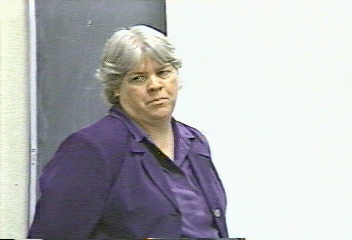
Eileen Bendixsen: "To have kids see that scientists are real people they;'re not people up in the clouds. Students start to see that they could become scientists."
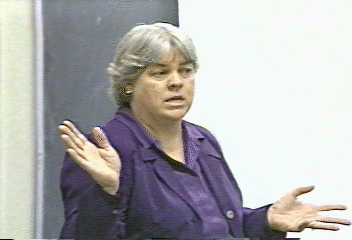
Eileen Bendixsen: "Researchers looking for something concrete. I don't give standardized tests. The concrete isn't in the classroom. I get feedback from my students and their parents that tell my this program is working."
Discussants: Melinda Brae, John Bransford, and Rick Dueschl (Learning Technology Center, Vanderbilt University), Jeff Darby, Claudia Kennedy, Sandra Lawrence, Betty Revercomb and Jeff Swink (Schools for Thought Teachers in Nashville, TN)
This presentation was a videoconference between Nashville teachers and researchers involved in Schools for Thought in Nashville and participants at the CSCL meeting in Toronto. Jeff Swink, one of two teachers in Nashville involved with the project from the beginning provided background and a description of the scaling up effort to include all Nashville middle and elementary schools. The primary focus of the dialogue concerned the changes teachers' had to make to implement Schools for Thought. These included the difficulty for teachers when they no longer had all the answers and needed to help students learn how to formulate their own questions, the difficulty in learning how to tell less and listen more to students' ideas, the difficulty of giving students more responsibility for their own learning, and the need to raise expectations for all students not just those students who had always been successful in school. Teachers mentioned the long-term professional development c!
ommitment from Vanderbilt and the gradual involvement of more teachers as key components in changing instructional practices successfully. Teachers also described an emerging problem in Nashville.
The Schools for Thought project, supported by a Challenge Grant to Nashville is intended to create classrooms and schools where collaborative knowledge building is the natural and adaptive thing to do all day and in all subject areas. This requires in depth and sustained student inquiry into central concepts that give meaning to a discipline such as science or history. In contrast, Hirsch's "Core Knowledge" curriculum adopted recently adopted by Nashville specifies information that students should acquire at each grade level. There is an inevitable tension between in depth study of a few concepts and covering a broad range of topics and teachers were clearly struggling to meet both.
Schools for Thought Videoconference
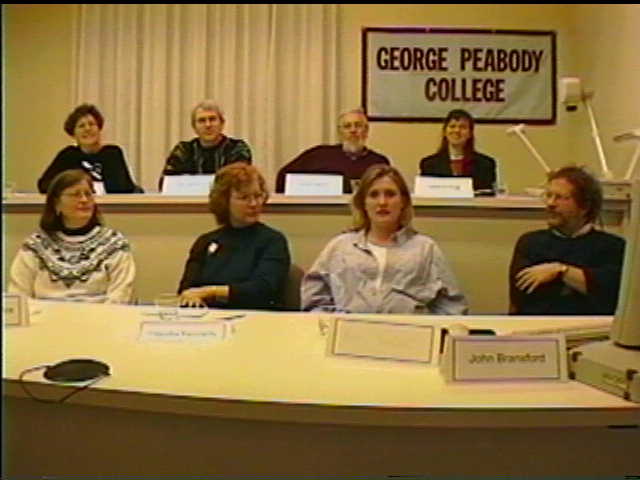
Vanderbilt teachers and researchers involved in the Schools for Thought project.
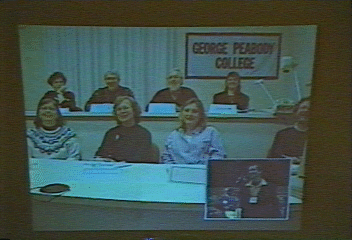
Jeff Darby (Nashville teacher): "The technology does do a great deal. Children seeing their work in writing helps them understand good explanations. As we gain more experience with the technology we can put it to greater use."
Panel on Teacher Issues in CSCL
Chair: Jan Hawkins (Center for Children and Technology, Educational Development Corporation)
Participants: Eileen Bendixsen (Middle School Science Teacher, Hazlet, New Jersey), Jeff Darby (Middle School Teacher, Nashville), John Moore (Burlington County Institute of Technology, Medford Campus, New Jersey), Richard Reeve (Institute of Child Study Laboratory School, Toronto). Jim Webb (Huron Street Public School, Toronto)
Clip 1: Jan Hawkins on teacher/researcher collaborations from her introductory remarks. (3:39)
At the conclusion of the Teacher Participation Program at CSCL '97, Jan Hawkins moderated a teachers' panel designed to highlight the commonalties and differences in teachers' approaches to implementing computer supported collaborative learning in their classrooms. Several themes emerged. First, teachers diverged in their approach to research and research products. At one end of the spectrum, there were teachers who were consumers and critics of research products. These teachers wanted to use the research-based technologies as long as they met the needs of their classrooms but expected to use other technologies as new needs developed. They saw their involvement with particular research projects as short term and while they were happy to contribute to data collection they did not see themselves as research collaborators. At the other end, there were teachers who were also researchers. For these teachers, their classrooms were their laboratories where they would try things ou!
t and work with university based researchers to continually improve the technology. These teachers had a long-term commitment to the projects they were involved in and saw themselves as contributing significantly to the research design. A research question that emerges is whether the teacher as intelligent consumer model and the teacher as researcher model have consequences for student learning.
All of these teachers were early adopters who had self selected to become involved in the various projects. Although they diverged in their technological expertise (indeed Moore pointed out that he had taken advantage of his lack of expertise and his students' technological savvy to turn responsibility for learning partly over to students), all had considerable content knowledge. Their enthusiasm and expertise shone through. One wonders what a panel of mainstream teachers, those who weren't early adopters, would have had to say CSCL. Is there a way to bring resistors into the dialogue?
Panel on Teacher Issues and CSCL
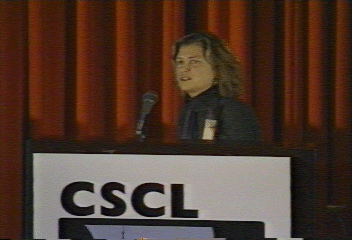
Jan Hawkins (panel chair): "I address this to the teachers: What has this collaboration been like for you? What surprises have resulted?"
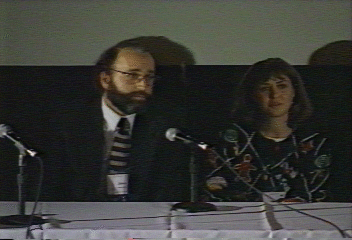
John Moore (CoVis team): "By chance I ran into Eileen Lento at another conference and my involvement with that particular project was the driving force into bringing the internet into our school. Now at the secondary level we're getting the technology. It is now up to you people (researchers) to step in and give us some direction."
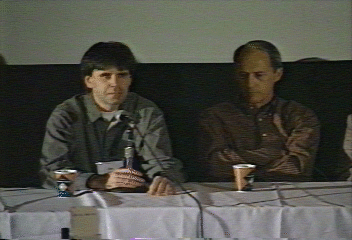
Jim Webb (CSILE teacher): "My experience has been somewhat different. We've been working on CSILE for twelve years now. That's one of the surprises for me. When we started with CSILE, Marlene Scardamalia suggested it might be a three year commitment. We started with the goal of developing some software to support intentional learning. And I think what we found out was that while the software is extremely important, in fact essential, what we are really about is changing the culture of the classroom. It has gone on and continues to do so."
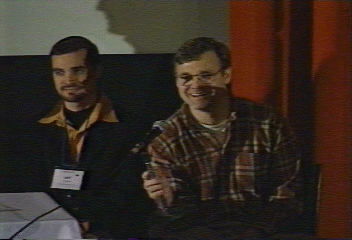
Richard Reeve (CSILE teacher): "This is my second year collaborating with Mary Lamon. I think the biggest surprise for me was the amount of support the relationship gave me. Last year the other teacher, Bev Caswell, and I were given something to read and at that moment that did something for us and we both changed our practice in some ways around those texts. The support is really important when there are so many "folkish" ideas about education out there."
Jeff Darby (Schools for Thought teacher): "William James said you can change your life if you change your attitude. You can change many lives if you happen to be a teacher. The largest surprise was how the technology changed me, the lessons learned, how we address our students. We are now at a deeper level and can't go back."